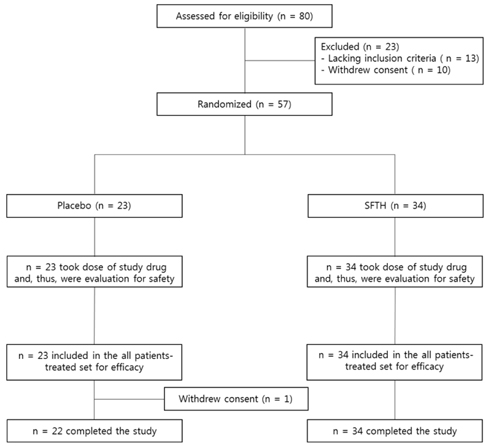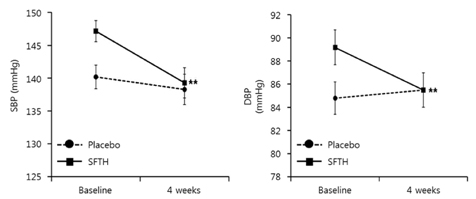Nutr Res Pract.
2017 Oct;11(5):396-401. 10.4162/nrp.2017.11.5.396.
Antihypertensive effect of an enzymatic hydrolysate from Styela clava flesh tissue in type 2 diabetic patients with hypertension
- Affiliations
-
- 1Marine-Integrated Bionics Research Center, Pukyong National University, Busan 48513, Korea.
- 2Department of Biomedical Engineering, and Center for Marine-Integrated Biomedical Technology (BK21 Plus), Pukyong National University, Busan 48513, Korea.
- 3Department of Pharmaceutical Engineering, Soonchunhyang University, 22 Soonchunhyangro, Shinchang-myeon, Asan-si, Chungnam 31538, Korea.
- 4Department of Internal Medicine, Gachon University Gil Medical Center, 21 Namdong-daero 774 road, Incheon 21565, Korea. drhormone@naver.com
- 5Department of Marine Life Science, Jeju National University, 102 Jejudaehak-ro, Jeju-si, Jeju 63243, Korea. youjinj@jejunu.ac.kr
- KMID: 2390132
- DOI: http://doi.org/10.4162/nrp.2017.11.5.396
Abstract
- BACKGROUND/OBJECTIVES
In this randomized, placebo-controlled, double-blind study, we evaluated the antihypertensive effects of enzymatic hydrolysate from Styela clava flesh tissue in patients with type 2 diabetes mellitus (T2DM) and hypertension.
SUBJECTS/METHODS
S. clava flesh tissue hydrolysate (SFTH) (n = 34) and placebo (n = 22) were randomly allocated to the study subjects. Each subject ingested two test capsules (500 mg) containing powdered SFTH (SFTH group) or placebo capsules (placebo group) during four weeks.
RESULTS
In the SFTH group, systolic and diastolic blood pressure decreased significantly 4 weeks after ingestion by 9.9 mmHg (P < 0.01) and 7.8 mmHg (P < 0.01), respectively. In addition, the SFTH group exhibited a significant decrease in hemoglobin A1c with a tendency toward improvement in homeostasis model assessment of insulin resistance, triglyceride, apolipoprotein B and plasma insulin levels after 4 weeks. No adverse effects were observed in other indexes, including biochemical and hematological parameters in both groups.
CONCLUSION
The results of our study suggested that SFTH exerts a regulatory, antihypertensive effect in patients with T2DM and hypertension.
MeSH Terms
Figure
Reference
-
1. Alberti KG, Zimmet P, Shaw J. IDF Epidemiology Task Force Consensus Group. The metabolic syndrome--a new worldwide definition. Lancet. 2005; 366:1059–1062.
Article2. Expert Panel on Detection, Evaluation, and Treatment of High Blood Cholesterol in Adults. Executive summary of the third report of the National Cholesterol Education Program (NCEP) Expert Panel on Detection, Evaluation, and Treatment of High Blood Cholesterol in Adults (Adult Treatment Panel III). JAMA. 2001; 285:2486–2497.3. World Health Organization. Global Health Risks: Mortality and Burden of Disease Attributable to Selected Major Risks. Geneva: World Health Organization;2009.4. Je JY, Park JY, Jung WK, Park PJ, Kim SK. Isolation of angiotensin I converting enzyme (ACE) inhibitor from fermented oyster sauce, Crassostrea gigas. Food Chem. 2005; 90:809–814.
Article5. Unger T. The role of the renin-angiotensin system in the development of cardiovascular disease. Am J Cardiol. 2002; 89:3A–9A.
Article6. Lee JK, Hong S, Jeon JK, Kim SK, Byun HG. Purification and characterization of angiotensin I converting enzyme inhibitory peptides from the rotifer, Brachionus rotundiformis. Bioresour Technol. 2009; 100:5255–5259.
Article7. Lapointe N, Rouleau JL. Activation of vascular tissue angiotensin-converting enzyme (ACE) in heart failure. Effects of ACE inhibitors. J Am Coll Cardiol. 2002; 39:776–779.
Article8. Rossi S, editor. Australian Medicines Handbook 2006. Adelaide: Australian Medicines Handbook;2006.9. Sidorenkov G, Navis G. Safety of ACE inhibitor therapies in patients with chronic kidney disease. Expert Opin Drug Saf. 2014; 13:1383–1395.
Article10. Ko SC, Kim DG, Han CH, Lee YJ, Lee JK, Byun HG, Lee SC, Park SJ, Lee DH, Jeon YJ. Nitric oxide-mediated vasorelaxation effects of anti-angiotensin I-converting enzyme (ACE) peptide from Styela clava flesh tissue and its anti-hypertensive effect in spontaneously hypertensive rats. Food Chem. 2012; 134:1141–1145.
Article11. Ko SC, Lee JK, Byun HG, Lee SC, Jeon YJ. Purification and characterization of angiotensin I-converting enzyme inhibitory peptide from enzymatic hydrolysates of Styela clava flesh tissue. Process Biochem. 2012; 47:34–40.
Article12. Matthews DR, Hosker JP, Rudenski AS, Naylor BA, Treacher DF, Turner RC. Homeostasis model assessment: insulin resistance and beta-cell function from fasting plasma glucose and insulin concentrations in man. Diabetologia. 1985; 28:412–419.
Article13. Lee JK, Jeon JK, Byun HG. Antihypertensive effect of novel angiotensin I converting enzyme inhibitory peptide from chum salmon (Oncorhynchus keta) skin in spontaneously hypertensive rats. J Funct Foods. 2014; 7:381–389.
Article14. Ko SC, Jung WK, Kang SM, Lee SH, Kang MC, Heo SJ, Kang KH, Kim YT, Park SJ, Jeong Y, Kim M, Byun HG, Jeon YJ. Angiotensin I-converting enzyme (ACE) inhibition and nitric oxide (NO)-mediated antihypertensive effect of octaphlorethol A isolated from Ishige sinicola: in vitro molecular mechanism and in vivo SHR model. J Funct Foods. 2015; 18:289–299.
Article15. Ko SC, Lee M, Lee JH, Lee SH, Lim Y, Jeon YJ. Dieckol, a phlorotannin isolated from a brown seaweed, Ecklonia cava, inhibits adipogenesis through AMP-activated protein kinase (AMPK) activation in 3T3-L1 preadipocytes. Environ Toxicol Pharmacol. 2013; 36:1253–1260.
Article16. Lee SH, Jeon YJ. Efficacy and safety of a dieckol-rich extract (AG-dieckol) of brown algae, Ecklonia cava, in pre-diabetic individuals: a double-blind, randomized, placebo-controlled clinical trial. Food Funct. 2015; 6:853–858.
Article17. Lee SH, Kang SM, Ko SC, Moon SH, Jeon BT, Lee DH, Jeon YJ. Octaphlorethol A: a potent α-glucosidase inhibitor isolated from Ishige foliacea shows an anti-hyperglycemic effect in mice with streptozotocin-induced diabetes. Food Funct. 2014; 5:2602–2608.
Article18. Jung ES, Park EJ, Park HR, Lee SC. Antioxidant activities of extracts from parts of Styela clava. J Korean Soc Food Sci Nutr. 2008; 37:1674–1678.19. Kang N, Ko SC, Samarakoon K, Kim EA, Kang MC, Lee SC, Kim J, Kim YT, Kim JS, Kim H, Jeon YJ. Purification of antioxidative peptide from peptic hydrolysates of Mideodeok (Styela clava) flesh tissue. Food Sci Biotechnol. 2013; 22:541–547.
Article20. Chung BH, Kim S, Kim JD, Lee JJ, Baek YY, Jeoung D, Lee H, Choe J, Ha KS, Won MH, Kwon YG, Kim YM. Syringaresinol causes vasorelaxation by elevating nitric oxide production through the phosphorylation and dimerization of endothelial nitric oxide synthase. Exp Mol Med. 2012; 44:191–201.
Article21. Ondetti MA, Cushman DW. Enzymes of the renin-angiotensin system and their inhibitors. Annu Rev Biochem. 1982; 51:283–308.
Article22. Kamiya A, Ando J, Shibata M, Masuda H. Roles of fluid shear stress in physiological regulation of vascular structure and function. Biorheology. 1988; 25:271–278.
Article23. Ko SC, Kim JI, Park SJ, Jung WK, Jeon YJ. Antihypertensive peptide purified from Styela clava flesh tissue stimulates glucose uptake through AMP-activated protein kinase (AMPK) activation in skeletal muscle cells. Eur Food Res Technol. 2016; 242:163–170.
Article24. Henriksen EJ, Jacob S. Modulation of metabolic control by angiotensin converting enzyme (ACE) inhibition. J Cell Physiol. 2003; 196:171–179.
Article25. Toda N, Arakawa K. Salt-induced hemodynamic regulation mediated by nitric oxide. J Hypertens. 2011; 29:415–424.
Article
- Full Text Links
- Actions
-
Cited
- CITED
-
- Close
- Share
- Similar articles
-
- Anti-inflammatory effect of enzymatic hydrolysates from Styela clava flesh tissue in lipopolysaccharide-stimulated RAW 264.7 macrophages and in vivo zebrafish model
- Isolation and Activity Evaluation of Peptides with Anti-hypertensive Activity from Commercial Enzymatic Flounder Fish Hydrolysate
- Clinical Observation on Antihypertensive Effect of Indapamide(R)
- Principles in the Treatment of Hypertension in the Elderly and New Classes of Antihypertensive Agents
- Comparing the Prevalence of Primary Aldosteronism in Hypertensive Diabetic and Non-diabetic Patients



